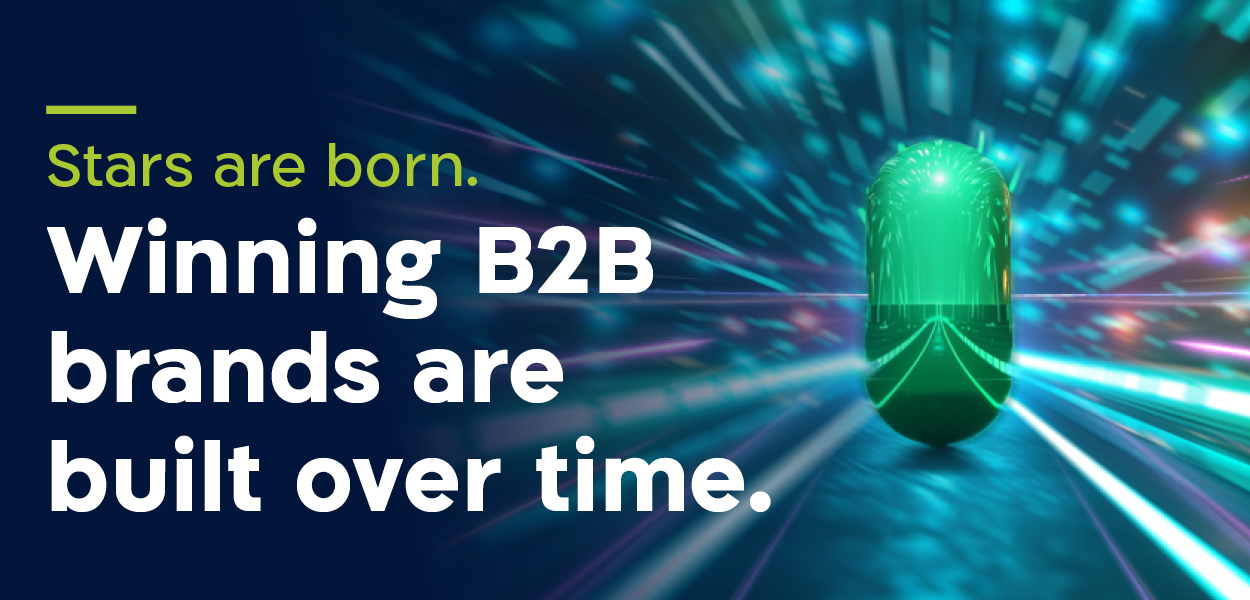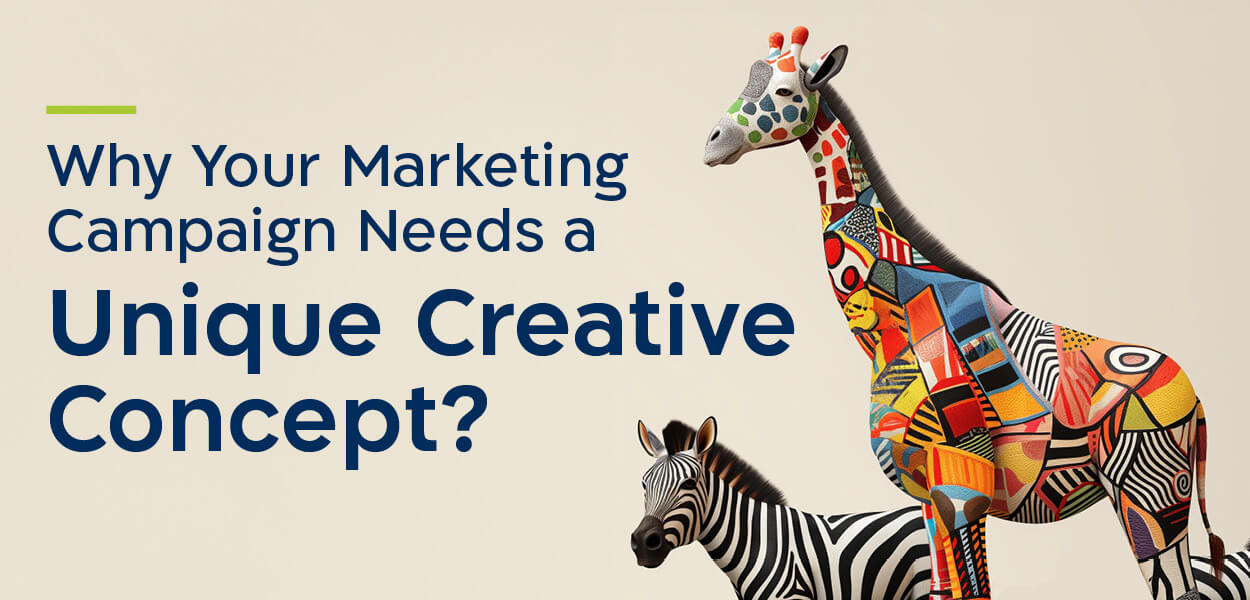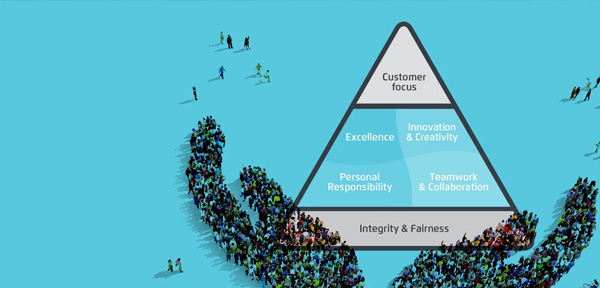The BL[OZ]
Rules, Regulations & Medical Brands How your medical brand can stand out within the regulatory framework
By
Nirit Elyovich, MBA
, 15/08/2024
Balancing marketing ambition with regulatory compliance is no easy task for medical brands. Our latest blog explores how early collaboration between marketing and regulatory teams can transform these challenges into opportunities, ensuring your brand stands out while staying compliant. Discover the smart strategies to help your brand shine within the regulatory framework.
When the journey takes an unexpected turn
During branding strategy kick-off meetings, we take a deep dive into your product, technology, and service. We’re looking for a fresh perspective, a promise not yet made, a story yet to be told. At this point, we get excited as we hear about groundbreaking technologies, solutions, and life-enhancing, life-prolonging products. Our jaws drop. With this WOW feeling, we continue the learning process in which we talk to customers, analyze the competition, and create a multi-participant meeting within the company to fine-tune its significant and differentiated strengths and generate outstanding benefits for its customers. As the process continues, we begin to understand the regulatory limitations. Suddenly, “Cinderella”, your extraordinary technology is being held back by regulatory limitations and is covered with “soot”.
Understanding limitations and optimizing capabilities
During the process, we’ve heard “It’s a given” or “It's powerful, but I can't confirm it" more times than we can count. Responses like these made us understand there must be a better way. That’s how our new module was born. It’s placed right at the beginning of the branding strategy process, which sets the stage for an open and guided dialogue between marketing and regulatory early on.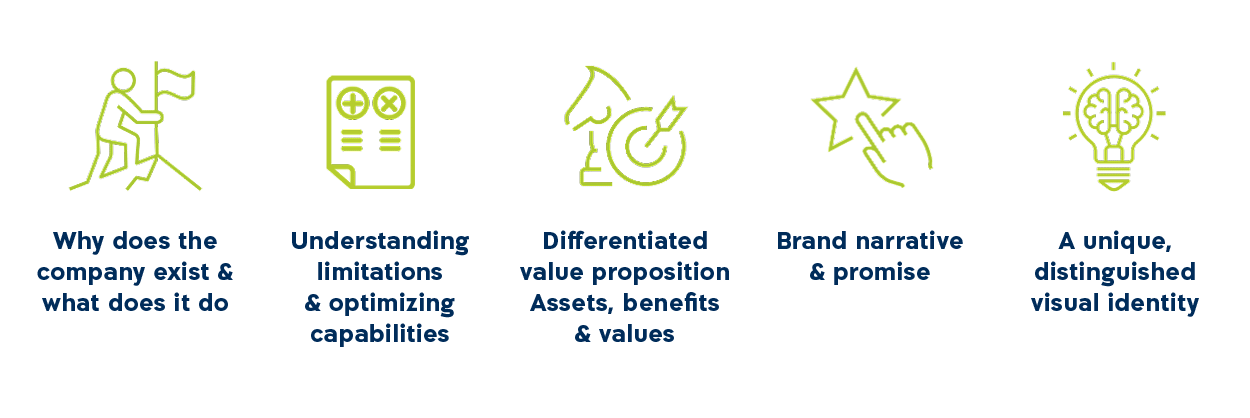
Challenging the norms
This dialogue is about helping the marketing team to understand the limitations in depth, and for the regulatory team to delve into the marketing team’s needs. It’s an authentic dialogue that creates a space to carry out activities that weren’t possible before. Understanding the precise needs opens up new perspectives and enables solutions within the boundaries of regulations. We understand the importance of compliance, but our experience shows that there are many degrees of freedom that are not being tested.It’s not about overstepping the bounds of the approved claims, but we also don’t want to take a step backward in the name of conservatism.
Sometimes it's a matter of overall wording, sometimes it's just changing one word. It's the little things that make a big difference. Stopping to ask questions often gives you a competitive advantage. Sometimes, there won’t be any flexibility in the claims you make, but at least you’ll know that you’ve turned over every stone.Structured and managed conflicts are an opportunity
Remember, whoever sits at the decision-making table wants the company to succeed and do the best they can. Inherently, conflict is not a negative; it can also be an opportunity. Don't let emotions run the process. As we often say, “Don’t be right, be smart!” As with every relationship where there’s an inherent conflict, there’s great value in professional guidance to create the conditions for a productive dialogue. To meet this need, we’ve created a special collaboration between OZ Global B2B and Leap, led by Moran Faibish, who has extensive experience in leading marketing in global medical companies. Moran has hands-on experience in bridging the gap between marketing and regulations to create deep and unique brand promises — promises that aren’t possible without providing an informed and professional framework that enables constructive communication.Play smart
The more we play smart within the regulatory limits to make the most of your claims, the more we can create a differentiated value proposition that more accurately reflects your breakthrough technology. This is how your brand will shine. We’ll be there every step of the way to guide the process, refine the messaging, and make sure your “WOW” comes through loud and clear. If you’ve nodded your head while reading this, it’s time for us to talk.


From Fruit Stand to Frontlines: The Unexpected Journey of the Watermelon Emoji
By
Rivi Kesten Buk
, 25/07/2024
Navigating digital symbolism can be intricate, but the case of the watermelon emoji adds a unique layer of complexity. It’s a prime example of how symbols can shape online narratives and influence global perceptions. This post uncovers the strategic use of the emoji and offers actionable ways to support pro-Israeli voices in the digital arena.
But first, a disclaimer: My name is Rivi, and I'm a proud Zionist (I believe in the Jews' right to self-determine in their ancestral homeland).
In recent years, while immersed in the online world of Hasbara, I’ve witnessed firsthand the challenges of representing Israel's narrative in a vast digital landscape. With Jews comprising just 0.2% of the global population, our voice can easily be drowned out in the maelstrom of social media.
This blog post examines a fascinating case study in digital activism: how a simple fruit emoji became a battleground for narrative control. We'll explore the marketing strategies at play and their implications for Israel's online presence. While we analyze these tactics objectively, our goal is to empower pro-Israeli voices in this ever-evolving digital dialogue.
At the end of this blog, you'll find actionable recommendations on supporting content creators who are amplifying Israel's perspective in the online world.
The Roots of a Symbol
As we approach National Watermelon Day on August 3rd, let's slice into a juicy marketing tale that's more complex than meets the eye. It's the story of how a simple fruit emoji became a powerful symbol in one of the world's most enduring conflicts. The roots of this story begin back in the 1960s, when the watermelon, with its colors reminiscent of the Palestinian flag, became a covert symbol of Palestinian identity. Palestinian activists used the watermelon imagery in graffiti and posters, primarily because in 1967, Israel passed a law prohibiting the raising or display of Palestinian flags (which had been canceled, during the Oslo Accords in the 1990s). The watermelon became a symbol of political resistance, and if we fast-forward to today's digital age, this symbol has found new life as an emoji, skillfully wielded by pro-Palestinian activists in their online narratives.

A Clever Marketing Strategy
But here's where it gets interesting from a marketing perspective: the use of the watermelon emoji isn't just a random choice. It's a clever strategy that serves multiple purposes:- Bypassing Algorithms: By using an innocuous fruit emoji, activists can often fly under the radar of content moderation systems. It's a digital sleight of hand that marketers call "Algospeak."
- Viral Potential: Emojis are the universal language of the internet. They're easy to use, easy to share, and can convey complex emotions and ideas in a single character. It's virality in its purest form.
- Continuity of Message: By adapting a historical symbol to modern digital platforms, the pro-Palestinian movement maintains a consistent narrative across generations. It's brand continuity at its finest.

The Israeli Perspective
Yet every story has another side. In Israel, where watermelons are a staple of hot summers and where the country produces a whopping 140,000 tons annually, this digital co-opting hasn't gone unnoticed. Enter the counter-narrative: Pro-Israeli social media users have begun their own campaign to reclaim the watermelon emoji. It's not about fruit anymore; it's about identity, representation, and the power of symbols in the digital age. Some Israeli users have started adding emojis of the Israeli flag, watermelon, and yellow ribbon (for the hostages) to their usernames, while others are creating actual content around watermelons: recipe videos, which are inherently popular on social media, featuring watermelons with the Israeli flag proudly displayed in the background. Other users (typically younger ones) are simply riding existing trends, adding watermelon eating to dances, trendy sounds, and more. Some have gone as far as creating simple online games centered around watermelons, while pro-Israeli creators are directly addressing the appropriation of the watermelon as a Palestinian symbol, calling it an unfounded act.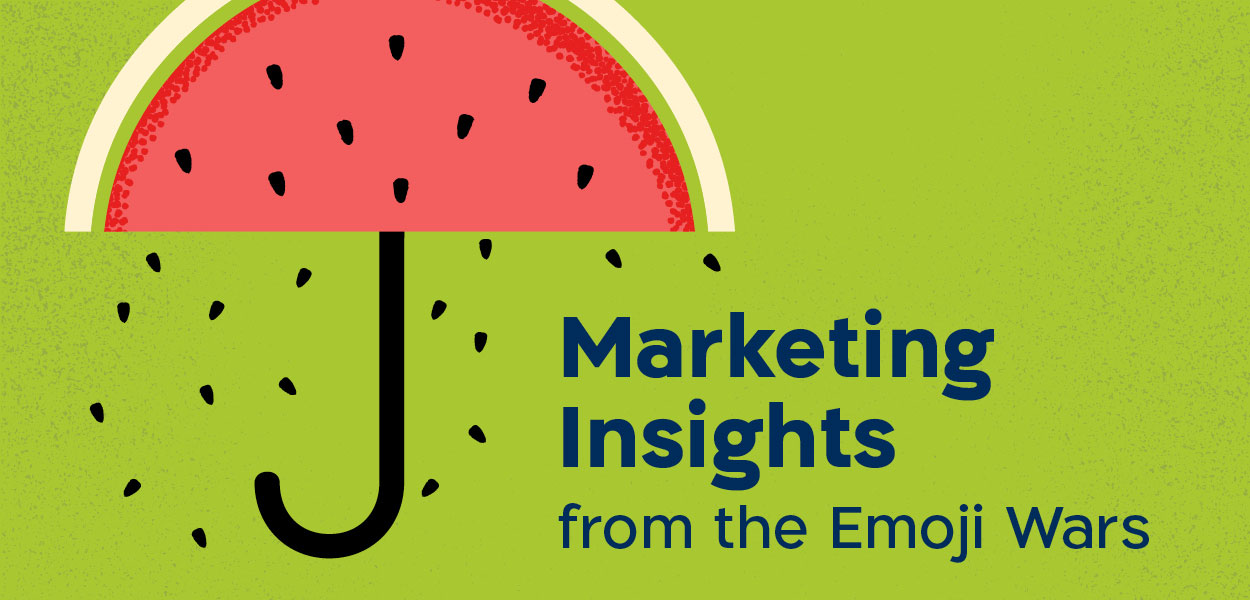
Marketing Insights from the Emoji Wars This digital tug-of-war offers fascinating insights for marketers:
- The Power of Symbols: Who knew a fruit could carry so much meaning? It reminds us that in the right context, even the simplest symbols can convey complex messages.
- The Importance of Proactive Strategies: The pro-Israeli response underscores the need for brands to be vigilant about their symbols and ready to reclaim them if necessary.
- Authenticity Matters: The most effective responses are those rooted in genuine cultural connections. Israel's agricultural tie to watermelons provides an authentic base for their counter-narrative.
- David vs. Goliath in the Digital Age: The pro-Palestinian digital presence significantly outnumbers the pro-Israeli one. It's a reminder that in the world of digital marketing, it's not always about who's loudest, yet sometimes it is.

Beyond Emojis: The Real-World Impact
While we engage in digital discourse, let's not forget the real-world stakes. Our brave soldiers are fighting daily to protect our nation and bring our hostages home. This online 'battle' is more than just emojis and trends; it's our way of supporting Israel's narrative on the global stage. As we participate in these digital efforts, we stand united with those on the front lines, showcasing the resilience and spirit of the Israeli people. Every post, every share, is a small act of solidarity that contributes to our national strength and resolve. In this digital age, we all have a role to play in supporting our country and its values.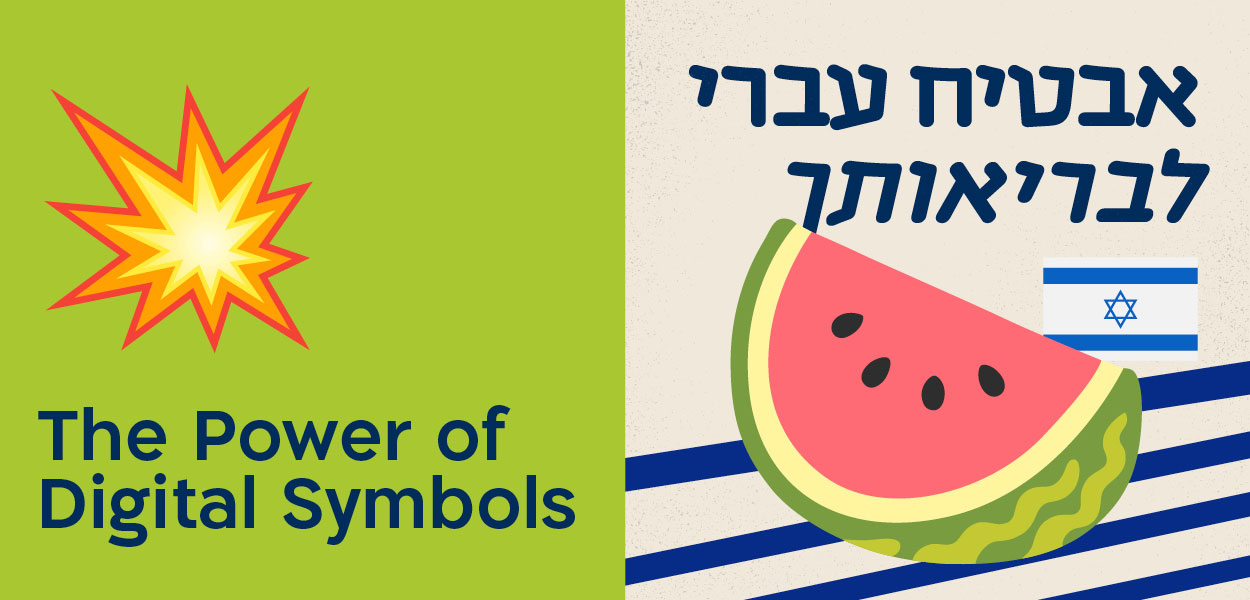
Conclusion: The Power of Digital Symbols
This National Watermelon Day, as we enjoy this summer fruit, let's also appreciate the complex world of digital symbolism it represents. It's a world where marketers, activists, and everyday users are constantly innovating, adapting, and yes, sometimes battling, in the ever-evolving landscape of online communication. After all, in the grand fruit bowl of digital marketing, the watermelon has proven it's not just a seasonal favorite – it's a year-round player in the game of global narratives. Join the Digital Movement Want to show some love to Israeli content creators this Watermelon Day? Here are a few ways you can contribute: 1. Follow prominent Pro-Israeli content creators: Adiel - TikTok Instagram Montana Tucker – Instagram TikTok Baby Ariel - TikTok Instagram Michael Rapaport – Instagram Tiktok Daniel Ryan Spaulding - Instagram TikTok Mia - TikTok Instagram Stop antisemitism – TikTok 2. Like and share posts featuring the "Hebrew Watermelon": instagram instagram tiktok tiktoK tiktok tiktok tiktok tiktok tiktok 3. Feeling creative? Use this trending TikTok sound to make your own Watermelon Day video: Tiktok Remember, this upcoming Watermelon Day might see increased pro-Palestinian activity on social media. For those of us who are pro-Israel and want to contribute, the methods mentioned above are a great way to start. Every like, share, and post counts in this digital age of narrative shaping. Let's make our voices heard while remembering the real battles being fought and the importance of standing united for Israel.Stars are born. Winning B2B brands are built over time.
By
Nirit Elyovich, MBA
, 07/07/2024
Brand building is always complex, but B2B brands bring a whole level of complexity that simply doesn’t exist in the B2C world. It's a golden opportunity to create a one-of-a-kind standout brand promise that will make a difference in the world.
Building a new brand or giving an existing brand a facelift, is a golden opportunity to create a one-of-a-kind standout brand promise that will make a difference in the world. Building a significant brand is complex, but B2B brands bring a whole level of complexity that simply doesn’t exist in the B2C world. Decision-making processes are lengthy, decision-makers come and go, and increasingly, the decision-makers are Gen Y and Gen Z. The road to the end user is paved with importers, distributors, and dealers. The orientation of most of the people you are working with is engineering or sales. Your brand needs to make its way into everyone's hearts on the long and winding road ahead. From time to time, I still hear that "in the business world, people make rational decisions." In my experience, people are people even when they sit in the decision-making chair. Their considerations are professional, business, and personal and the brand needs to touch all these points
A meaningful brand must be relevant, differentiated, and inspired1. Be relevant
Before you begin, define your audience. Unlike launching a product line that appeals to distinct customers, a B2B brand speaks to a wide range of audiences – existing and potential customers, employees and candidates, investors, suppliers, opinion leaders, and influencers.
However, you operate in a very specific world, so finetune the audience that interests you and create circles of influence. Who is in the first circle and who is in the more distant circles? The brand needs to speak directly and accurately to members of the first circle and still be relevant to other circles.
To be relevant, you need to know your audience, what their challenges are, and where you can help them deal with their challenges well. To motivate people, we must touch their “operating” buttons, speak their language, and solve the problems that bother them. We want to sell them what they want to buy and not what we want to sell — even if it's the same thing.
2. Build a differentiated value proposition
To build a differentiated value proposition, start with A, B, and C: Assets, Benefits, and Core Values. Assets – What are your biggest assets? What strengths are you most proud of? Make a list of the things you're best at – unique patented technology, people with unique knowledge, exceptional support and service, and more. Make sure that every strength that makes up your list is grounded in reality, and not an aspiration for something you'd like to have. From the list, extract the three most significant strengths. As much as possible, select those that differentiate you from the competition. Benefits –Step into your customers' shoes and think about what they get out of your strengths. This is where you ensure that you provide professional benefits that help them upgrade their professional field; business benefits that contribute to their business performance; and no less important, personal benefits. Ultimately, everything is personal simply — because people want to make sure that choosing you promotes their reputation within the organization. Core Values – Brand values are always important, but even more so in the B2B world. People are an integral part of your value proposition – whoever defines the specifications with the customer, develops, sells, installs or integrates, provides service and support – all these and more bring the brand to life. They must follow a uniform set of values to ensure that they deliver the benefits to the customer and subsequently deliver on the brand promise. If the company was founded recently, the values may be naturally infused into the brand. If the company is alive and kicking, the values are usually passed down over the years. Make sure the values reflect the company's DNA.
There's nothing new under the sun You may find that your competitors have an asset, benefit, or value that appears to be similar to yours. However, the combination of assets, benefits, and values must be unique to your company. That's why starting with unique assets and formulating benefits that address your clients' deep and diverse needs is important.
The more you get to know your clients, the more likely you will produce differentiated benefits. This is another opportunity for differentiation: your founders, owners, and significant employees are the unique spirit that makes your company what it is.

3. Bring inspiration to life with a promise
To make sure your brand inspires you and everyone you meet, go back to your vision. The thing that fascinated you when you started your business or that attracted you to join the company. The reason you get up in the morning and go to work. The North Star lights the way for you, even on days when visibility is poor. Your vision is an ambitious statement that describes what your organization ultimately wants to be. Spoiler alert: you're not supposed to get it, you’re supposed to aspire to reach it. As Aviv Geffen put it, " The moon is so high up there that we can't touch it, and there are some who are still trying.” Your vision is there to lift you high above your daily activities and inspire you.

Building or refreshing a brand is a strategic task
Don’t cut corners. Enjoy the journey as much as the destination. Get as many people involved in the process as possible to make everyone feel a part of it. This is how to make them the best ambassadors for your brand.
Formulating a brand strategy is an extremely important and complex process, but it’s only the beginning. From now on, the entire organization has to fulfill it, to bring the brand into the lives of those who experience it exactly as you intended. In the B2B world, your brand will touch a lot of people for many years to come. Make sure that everyone has the same experience, irrespective of the language they speak.
A brand is a promise. A strong brand is a promise that is fulfilled every day in every encounter between the brand and the world.
Don’t Get Lost in the Scroll: Why Your Marketing Campaign Needs a Unique Creative Concept
By
Timrat Erez
, 20/05/2024
Unlock the potential of every marketing move with the right creative concept that distinguishes your campaigns from the day-to-day brand strategies.
Creative Cracking: The Art of Standing Out
Creative cracking refers to the process of developing a distinctive creative concept that adds a layer of uniqueness and power to your digital marketing campaigns. It's about breaking through the norm, providing a fresh perspective that draws attention and maintains it, and achieving a high rate of engagement. This process is like how different products under the same brand differentiate themselves through packaging. Similarly, each marketing move should encapsulate a distinct message and visual style that communicates its unique value proposition and resonates with specific target audiences. A successful marketing campaign must go beyond the typical visibility of the brand. It must be distinctive in its visual presentation and messaging. This requires a deep understanding of the product's features, qualities, and the demographics it aims to attract. By aligning these elements with a creative concept that pops, the campaign delivers its message with increased impact and memorability.When to Launch a Creative Concept?
So, how do you know when it's time to invest in a creative concept campaign? Here are a few key moments: • Launching a New Product: Generate excitement and buzz around your latest offering with a campaign that speaks directly to your target audience's needs and desires. • Entering a New Market: As you venture into uncharted territory, a creative concept campaign can help you build brand awareness and establish yourself as a leader in the new space, enhancing your brand recall. • Making a Big Announcement: Whether it's a shift in your industry focus or a strategic partnership, a creative campaign can add weight and memorability to your message.From Insights to Impact: Our Creative Concept Process
At Oz Global, we understand the power of storytelling real-time marketing. We take a data-driven approach to developing creative concepts, working closely with you to understand your specific needs, target audience, and brand voice. Here's how we do it - Laying the Groundwork: Gathering Information and Formulating Ideas Our approach begins with gathering comprehensive information about your business objectives, the competitive landscape, and your target audience's preferences. This phase is crucial as it lays the groundwork for crafting marketing moves that are not only creative but also strategically aligned with your business goals. Visuals and Messages that Speak Volumes With a clear understanding of your marketing goals and audience insights, we move ahead to shape the visual and narrative elements of your campaign. This involves selecting colors, typography, and imagery that align with the brand's identity while introducing something new and exciting. Continually experimenting and testing directions, before zooming in, selecting, and finetuning the winning concept. And a new creative direction (or two) is born. Concept Ideas: The Survival of the "Fittest" Once you choose the path that best aligns with your vision, we'll get working on crafting an engaging campaign that extends across your channels. From a captivating landing page to eye-catching social media banners, every touchpoint will, from this moment on, speak the same creative language, cementing your brand identity, generating buzz, and driving high-rate engagement. Bringing Creative Concepts to Life After finalizing the design, we bring the creative concept to life across various platforms and touchpoints. Whether it's digital ads, social media content, or physical marketing materials, every element is designed to reflect the unified creative concept, ensuring consistency and boosting brand recall.Why Creative Concepts are Marketing Gold
To break through the noise and engage professional audiences effectively in B2B marketing, creative concepts are a must. With innovative marketing strategies, that tap into your audience's emotions (emotional appeal), a standard product launch can turn into a compelling business story that lands on the desks of decision-makers. Creative concepts help to raise the perceived value of a product or service and build meaningful connections with your customers, driving conversions and strengthening long-term partnerships. By prioritizing creativity, B2B companies can make sure their marketing efforts are seen, remembered, and acted upon. And don't forget the power of a clear call to action (CTA) during a targeted product or service marketing campaign! Whether it's encouraging a visit to your dedicated landing page, downloading your white paper, or signing up for an upcoming webinar, a strong CTA will ensure your audience knows exactly what you want them to do next.Your Story, Amplified
Employing a unique creative concept does more than just attract attention, it amps up all your marketing efforts, by - - Standing out: It separates your campaign marketing moves from your ongoing brand marketing programs, helping your campaign stand out. - Boosting Engagement: Adding visually appealing and message-oriented concepts helps make a campaign more memorable and engaging. - Building Long-term Brand Recall: Just as unique packaging can make products memorable, unique creative concepts can help marketing moves linger in the minds of consumers, helping to achieve long-term brand recall.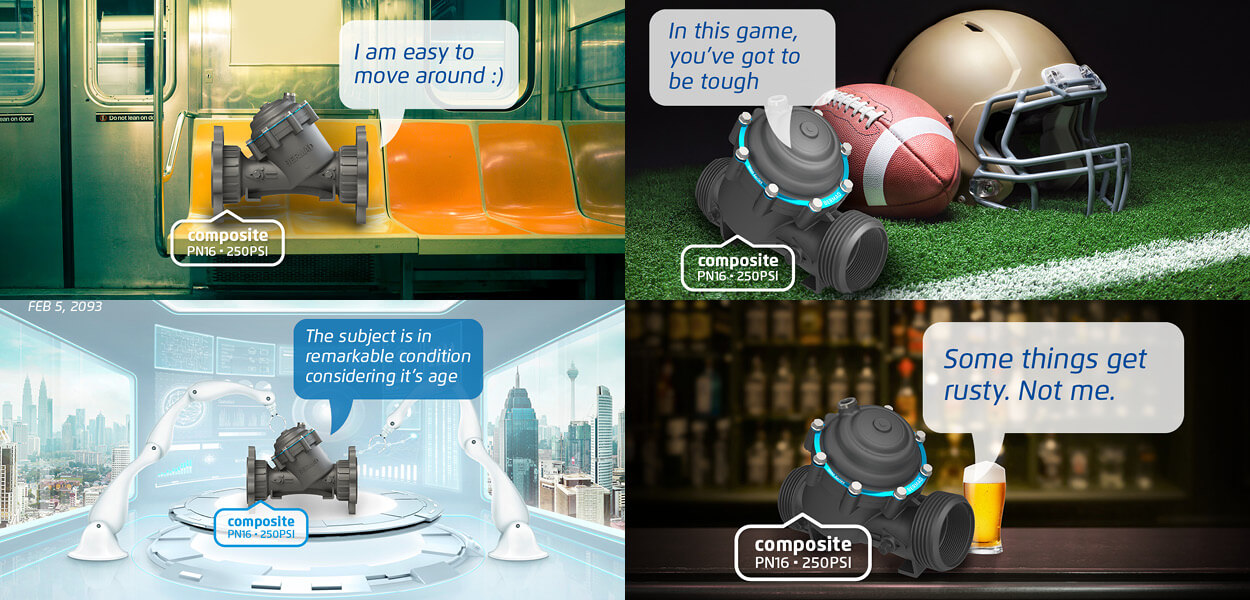
A Final Thought
For a marketing move to be successful, it needs a strong creative element. In the same way that different products of the same brand thrive in unique packaging, each marketing campaign needs its own creative concept to make sure it speaks directly and powerfully to the target audience. Not only does it boost visibility, it leaves a lasting impression. So, are you ready to break free from the monotonous scroll and make a lasting impact? Let us help you develop a creative concept campaign that gets noticed, remembered, and drives real results.Branding 101 – The Branding Process Explained
By
Inbar Telem
, 03/09/2023
Want to know the secret sauce of branding? Our latest blog post has it all! Learn how inspiration fuels our journey, how design brings brands to life, and how businesses evolve through effective branding. Click here to uncover the branding recipe for success!

Step One – How to Start the Branding Process for a Business?
The start is life itself, because every day we're exposed to hundreds of messages, ideas, videos, texts, and images. Later it all comes together, and our mind begin processing all these inspirations into new, original, and unique design and language for a specific client. At Oz, we make sure our team, in this case, our designers, is exposed to diverse content worlds and various content styles. This opens up their minds to creativity, from which different brands for different companies can blossom (even if they're in the same industry, they'll create something unique and original – that's the beauty of it!). The branding process for a business begins as a strategic process where we research and analyze the brand, the product, the company, or the service – and answer the age-old questions – what is the company's vision, what makes the company special, what customers expect, and what the competition offers. To differentiate the brand effectively, it's essential to examine competitors – what visual and textual language they use, what messages they convey to the world, and what their customers think of them. During this examination, we come across tons of content and inspiration on the web, and it's a fantastic process. All the research and in-depth analysis, combined with the ideas and inspirations, meld together to form the foundation of the brand – the unique value proposition, the narrative, the promise, and the brand's values.
Step Two – How to Implement the Branding Process?
This is the step everyone seems to be familiar with – the name, logo, fonts, color palette. Supposedly. Since everyone talks about this step, it's crucial to understand that without a solid foundation and thorough research, it won't work. The brand's cornerstones (based on the strategic messages, remember?) need to be creatively and visually translated into the brand's language – both in verbal elements (the brand's name and slogan) and visual elements (the logo, fonts, shapes, and colors). The brand's domain, characteristics, and values will be expressed through its visual appearance. Importantly, the design should not only be eye-catching but should also have longevity. Trends come and go, but your branding should remain stable for years. Our designers have the ability to translate the emotional world into the visual world, making your target audience express positive emotions, identify with your brand, and remember your look (for the next time they encounter you) – or in short, to create an impactful brand for you.
Step Three – How Does a Business Change as a Result of Branding?
So, we've gathered inspiration, worked with a professional branding agency (like OZ, ahem), researched, and analyzed, and the designers have prepared sketches. And the most exciting part – the management approved it! So now what? Implementation! At the end of the branding process and the creation of the brand's visual language, it's time to infuse it into every marketing and reputation aspect of the company. The new language will be applied across the board – on social networks, envelopes, outdoor signs and ads, physical offices, pens and notebooks – anything that comes to mind (and if it doesn't, our client managers have plenty of ideas). Effective design is measured by its versatility. If the base has a strong and focused idea, it will be clear how to continue and develop that into the brand's language in every format – digital and print.Rebranding – so much more than just a logo or color palette
By
Miri Peled
, 19/02/2018
Rebranding – so much more than just a logo or color palette. What you'll need to do when rebranding.
Refresh or rebrand?
When rebranding, you can either refresh and improve your current branding or start over and create an entirely new one. No matter what you decide, the rebranding process involves a lot more than designing a new logo or changing your corporate color palette. Here’s what you’ll need to do:- Defining a clear rebranding strategy.
- Reanalyzing your company’s vision, mission and values.
- Conduct market research and competitor research including new players who may have popped up more recently.
- Research existing customers, potential customers and target audiences.
- Redefine your message.
- Create a new visual identity.
- Create new marketing materials.
- Relaunch your brand (internally and externally).
Spreading the news
The rebranding journey can sometimes be confusing for your employees and customers who have become accustomed to your existing brand identity. Use this as an opportunity to reconnect with them and clearly communicate during the process and after its completion. If you want the transition process to be a success, you should be as transparent as possible and clearly communicate these changes both internally and externally.Rebranding with OZ
At OZ, we understand the complexity of rebranding and our team has extensive experience helping our customers successfully navigate the rebranding process. We can use this experience to successfully guide you through it from planning through to implementation and beyond.10, 9, 8…. And counting down marketing trends for 2018
By
Orit Oz
, 18/01/2018
The New Year is here and we put together a countdown of marketing trends that will affect B2B brands in 2018!
10 – Visual content
 The trend for visualization through video, images and infographics will get stronger. In fact, predictions indicate that by 2019, video will account for 80% of consumer internet traffic. And, according to Facebook, live is even better and live video gets 3x more views and is expected to dramatically increase in 2017. B2B brands can use live videos in lots of different ways, including at events to give followers a behind-the-scenes look, host interviews with key influencers, and launch promotions.
The trend for visualization through video, images and infographics will get stronger. In fact, predictions indicate that by 2019, video will account for 80% of consumer internet traffic. And, according to Facebook, live is even better and live video gets 3x more views and is expected to dramatically increase in 2017. B2B brands can use live videos in lots of different ways, including at events to give followers a behind-the-scenes look, host interviews with key influencers, and launch promotions.
9 – Big (big) data
 Big data’s been a big trend for many years now, but it’s become more accessible because of machine learning and AI. As more and more platforms and marketing methods start incorporating big data, the use of big data is becoming an essential part of marketing and understanding what the consumer wants and when is worth its weight in gold.
Big data’s been a big trend for many years now, but it’s become more accessible because of machine learning and AI. As more and more platforms and marketing methods start incorporating big data, the use of big data is becoming an essential part of marketing and understanding what the consumer wants and when is worth its weight in gold.
8 – Authenticity
 Transparency and trust have become a major component of the customer’s decision-making process as customers’ become less and less tolerant towards fake news and reviews, or in other words, exaggerated marketing. Brands should invest in community management to keep the online community engaged, informed and happy; and can use technology advances such as virtual reality (VR) and augmented reality (AR) to connect with users on a deeper, more emotional level.
Transparency and trust have become a major component of the customer’s decision-making process as customers’ become less and less tolerant towards fake news and reviews, or in other words, exaggerated marketing. Brands should invest in community management to keep the online community engaged, informed and happy; and can use technology advances such as virtual reality (VR) and augmented reality (AR) to connect with users on a deeper, more emotional level.
7 – Content and influencer networks
 There is no arguing with the fact that content is still king. However, there is a need to deal with the challenge of oversaturation. Now that most brands have some sort of content strategy and social media networks are full of content, the focus needs to shift slightly. Rather than fighting for more visibility, marketers will need to think out of the box and stand out in space that is already taken. This is where influencers come into the picture. By leveraging the networks of influencers who already have a “captive” audience, marketers can increase their online influence and start to reduce the volume of content produced, or in other words, go for quality and not quantity.
There is no arguing with the fact that content is still king. However, there is a need to deal with the challenge of oversaturation. Now that most brands have some sort of content strategy and social media networks are full of content, the focus needs to shift slightly. Rather than fighting for more visibility, marketers will need to think out of the box and stand out in space that is already taken. This is where influencers come into the picture. By leveraging the networks of influencers who already have a “captive” audience, marketers can increase their online influence and start to reduce the volume of content produced, or in other words, go for quality and not quantity.
6 – Shift of focus from millennials to Generation Z
 Born between 1995 and 2010, this consumer group marks a substantial shift that will affect all brands. These digital natives are different from millennials and they will have increased buying power in the near future. Keep an eye out on key platforms such as Snapchat and Instagram when targeting this young and highly dynamic demographic.
Born between 1995 and 2010, this consumer group marks a substantial shift that will affect all brands. These digital natives are different from millennials and they will have increased buying power in the near future. Keep an eye out on key platforms such as Snapchat and Instagram when targeting this young and highly dynamic demographic.
5 – Mobile, mobile, mobile
 We cannot emphasize this one enough. Consumers are spending most of their time on their mobile phones. In fact, in 2018, mobile video consumption is expected to grow by 25% and ad spending on mobile video will reach 18 billion dollars next year, surpassing desktop. Even Google has even given priority to pages that are AMP optimized (Accelerated Mobile Pages). So the bottom line is that if you haven’t yet done so, you need to start optimizing your marketing strategies, websites and ads for mobile.
We cannot emphasize this one enough. Consumers are spending most of their time on their mobile phones. In fact, in 2018, mobile video consumption is expected to grow by 25% and ad spending on mobile video will reach 18 billion dollars next year, surpassing desktop. Even Google has even given priority to pages that are AMP optimized (Accelerated Mobile Pages). So the bottom line is that if you haven’t yet done so, you need to start optimizing your marketing strategies, websites and ads for mobile.
4 – Shift in KPIs
 While it’s still important to know how many people visited your site and from where, at the end of the day it’s all about sales. For this reason, it’s important to track conversions and revenue, in other words, who buys and at what stage of the buyer’s journey. In this way, it becomes easier to track your return of investment on digital marketing.
While it’s still important to know how many people visited your site and from where, at the end of the day it’s all about sales. For this reason, it’s important to track conversions and revenue, in other words, who buys and at what stage of the buyer’s journey. In this way, it becomes easier to track your return of investment on digital marketing.
3 – Data protection
 The digital age brings with it the need to take multiple aspects including data privacy into account. In May 2018, the General Data Protection Regulation (GDPR) will take affect with the aim of improving protection for EU citizens and adapting privacy and data laws to the digital age. This will require marketers to think and act very differently as it will affecter multiple factors in a marketer’s focus, some of which require organizations to start preparing immediately.
The digital age brings with it the need to take multiple aspects including data privacy into account. In May 2018, the General Data Protection Regulation (GDPR) will take affect with the aim of improving protection for EU citizens and adapting privacy and data laws to the digital age. This will require marketers to think and act very differently as it will affecter multiple factors in a marketer’s focus, some of which require organizations to start preparing immediately.
2 – Native ads and smart content
 Native advertising is expected to drive more than 74 percent of all add revenue by 2021. Because of their more natural placement and format, these ads usually get more exposure and engagement than traditional banner ads. However, these ads need to be written according to the preferences of those seeing the ads, and they should also be linked to “smart content” that is adapted to audiences based on NI, cookies and an in-depth understanding of target audiences.
Native advertising is expected to drive more than 74 percent of all add revenue by 2021. Because of their more natural placement and format, these ads usually get more exposure and engagement than traditional banner ads. However, these ads need to be written according to the preferences of those seeing the ads, and they should also be linked to “smart content” that is adapted to audiences based on NI, cookies and an in-depth understanding of target audiences.
1 – Take advantage of the FOMO effect
 Even though we already mentioned this one in a previous point, we think it deserves to be repeated for emphasis. As more and more people experience the FOMO (Fear of Missing Out) effect, marketers need to create unique and original content that makes potential customers feel like they’re the first to know. For example, content that involves a “behind-the-scenes look”, an exclusive with an influencer, or a sneak preview of upcoming projects and product launches can be used to really create a buzz and get potential consumers to engage “before” anyone else does.
Even though we already mentioned this one in a previous point, we think it deserves to be repeated for emphasis. As more and more people experience the FOMO (Fear of Missing Out) effect, marketers need to create unique and original content that makes potential customers feel like they’re the first to know. For example, content that involves a “behind-the-scenes look”, an exclusive with an influencer, or a sneak preview of upcoming projects and product launches can be used to really create a buzz and get potential consumers to engage “before” anyone else does.
Opportunities for Israeli B2B companies looking to China
By
Mike Golden
, 01/01/2018
Israel and China are a perfect match – China is an incredible opportunity for Israeli cyber-security, medical devices and artificial intelligence industries.
How to break into the Chinese market:
Understand the target customer and other stakeholders Find the right strategic partners to help you. Consumers in China are entirely different than what you are used to. They are on different channels, they have different expectations, and there are important cultural norms you’ll want to be aware of. A local team on the ground with the experience and tools to understand and effectively target customers is crucial to preventing big blunders. Regulatory concerns It is critical to spend time researching and understanding the regulatory environment prior to making any decision to enter the market. China has extremely strict laws protecting consumers, including quality, standards and other regulations covering most industries. Sensitive industries such as medical devices and pharmaceutical are especially strict. Trademark everything, immediately As soon as your product comes on the scene in China you can bet there will be copycats. We’ve seen it with big brands and small, if you don’t take trademarking seriously, you run the risk of expensive, messy and prolonged legal battles. Before talking to anyone, start the trademark process and make sure you own the corresponding Chinese domain names (.cn and .com.cn). Don’t assume what works in the West will work in China Look no further than eBay and Uber, two remarkably successful international companies that failed in China. Chinese consumers have different tastes, different expectations, different cultural norms and customs that are deep-rooted in society. On top of all of this is an unrelenting drive for innovation, which makes brands with a weak positioning strategy extremely vulnerable. If you take your brand to the China market and your messaging is unclear, or your branding is weak, there is a good chance your product or service will be copied and eaten up by a domestic brand. Find a decent Chinese name It doesn’t have to be a direct translation, or even exactly the same as the Western version. The Mandarin language is comprised of thousands of characters that all have a great deal of significance. Meaning there are lots of options for translations that can turn out great, or translations that can turn out… not so great. AirBnB fell prey to a naming mishap when they entered the Chinese market as 爱彼迎 (Àibǐyíng), which they explained means “let love meet each other” but to native Chinese this name conjures up images of a “love hotel”, and many complained that it is awkward to pronounce. Even if you think you’ve settled on a great name, test it, test it and test it again. Start with distribution and expand from there You don’t need to set up shop right away. After you’ve trademarked everything, going through a distributer to test the waters is a good way to enter the China market. Many SME’s in the medical industry routinely work with distributors to get their products into hospitals in China. Set up your website Number one piece of advice; put your Chinese website on a server in China or Hong Kong. Shrinking attention spans haunt every content marketer, so don’t lose your audience even before your beautifully, well-crafted home page loads. If you are hosting on a local Chinese server you are required to apply for the ICP license and this also means you need to have a local entity already organized. You’ll typically need to apply for an ICP license from the Chinese Government; this will lead to better search results on Baidu and allows you to run PPC campaigns. Don’t forget to make your website mobile optimized! In China more than 95% of Internet users are using their mobile phones to access it. Choose the right trade shows This goes hand-in-hand with understanding your target customer and stakeholders. There are hundreds of trade shows in China every year, with thousands of exhibitors. It can be tempting to try and get your foot in the door to as many as possible, but this will leave you out of budget and exhausted quickly. Can you team up with similar brands? Make connections with attendees beforehand? Enter social media with your big toe in the water With all the hype around WeChat in China, many brands are ready to dive headfirst and go all out for this mega-app, but take a step back. WeChat is completely different than Facebook, Instagram or any other typical social media platform you are familiar with using. It is important to set the right expectations, and the right strategy. Become well versed with the app, it’s functionality and it’s limitations before setting your KPIs. While it is important for brands to have a WeChat account, there may be other channels to investigate.The importance of branding in launching new products
By
Orit Oz
, 15/05/2017
Prior to the recent release of Mazor X, Oz Branding worked with Mazor Robotics to create a compelling brand promise for the new product — Align with Experience.
“Branding In” in International Branding
By
Dina Gidron
, 15/05/2017
The answer lies in understanding the clear link between your B2B brand and your employees’ connection to your brand promise
How can we ensure that we don’t lose or dilute our essential values and brand promise as we become a cross-continent corporation?
The answer lies in understanding the clear link between your B2B brand and your employees’ connection to your brand promise – no matter where they are in the world.By focusing on both implementing your brand in the global marketplace and strengthening your brand within your organization, you can more easily coordinate cross-continent corporate cultures and processes to define a common global branding language and presence that is consistently implemented across all touch points and markets. When Maytronics, a global leader in automated pool cleaning solutions, began to expand globally, the company looked for ways to build a strong and growing global brand while still maintaining a unique company culture, value, and DNA.
With a focus on its core values, Maytronics and Oz Branding began a worldwide organizational and branding process that included the enhancing of the internal company dialog to reinforce its brand promise of Exceptional Experience.
When Maytronics, a global leader in automated pool cleaning solutions, began to expand globally, the company looked for ways to build a strong and growing global brand while still maintaining a unique company culture, value, and DNA.
With a focus on its core values, Maytronics and Oz Branding began a worldwide organizational and branding process that included the enhancing of the internal company dialog to reinforce its brand promise of Exceptional Experience.
How B2B Brands Drive Sales
By
Orit Oz
, 14/05/2017
One of the most difficult parts of B2B branding is selling the brand to sales. Many B2B brands fail because they haven't been integrated into the sales force
 https://www.linkedin.com/pulse/global-b2b-brands-highest-brand-value-waldemar-pfoertsch
What can we learn from this? Well, for one, that B2B purchasers are human beings at the end of day. They are a lot less value-driven than they like to think, and heavily swayed by the brand, which helps them simplify evaluating the product.
https://www.linkedin.com/pulse/global-b2b-brands-highest-brand-value-waldemar-pfoertsch
What can we learn from this? Well, for one, that B2B purchasers are human beings at the end of day. They are a lot less value-driven than they like to think, and heavily swayed by the brand, which helps them simplify evaluating the product.
Getting the Sales Team on Board
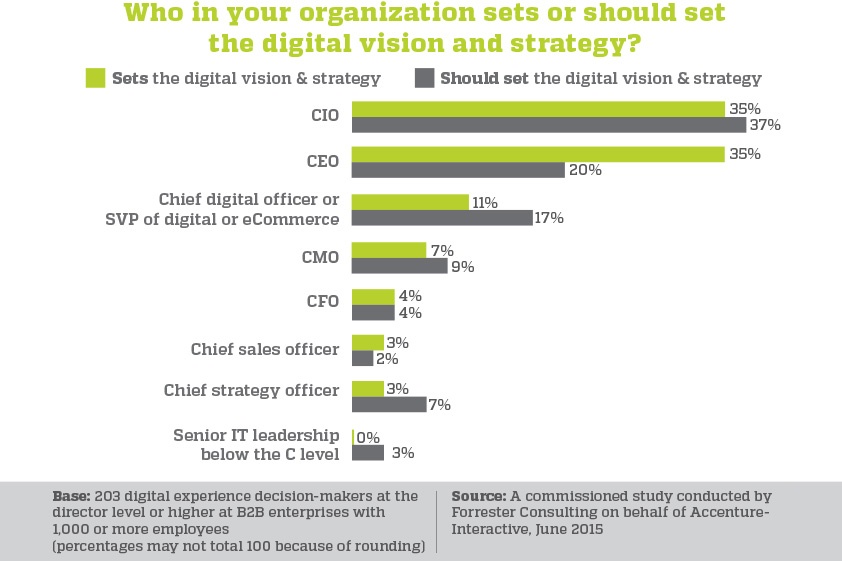 Despite the enormous added-value of a strong brand in a purchasing price, one of the most difficult parts of B2B branding is selling the brand to sales. Many B2B brands fail because they haven't been properly integrated into – and accepted by – the sales force.
To ensure that your brand is accepted by your salespeople, you'll want to make sure you're providing the answers to these questions:
Despite the enormous added-value of a strong brand in a purchasing price, one of the most difficult parts of B2B branding is selling the brand to sales. Many B2B brands fail because they haven't been properly integrated into – and accepted by – the sales force.
To ensure that your brand is accepted by your salespeople, you'll want to make sure you're providing the answers to these questions:
1. Are You Telling the Right Brand Story?
It can be helpful to first take a step back and reevaluate if your internal B2B brand story is the same of that of your customers. The same McKinsey study from above found that often the two audiences focused on completely different things --- B2B suppliers focused on sustainability, global reach, and corporate responsibility whereas customers focused on honesty, responsibility across the supply chain, and level of specialized expertise.2. Do Your Salespeople Understand What a Brand is?
Your salespeople need to understand that a brand is what happens before you enter a room and after you leave. It also provides a framework for communicating the values behind your company's product or service.3. Do Your Salespeople Understand How A Brand Can Help Them?
This is where "branding in" can be vital. "Branding in" connects the entire company to the brand promise and implements it in their day-to-day responsibilities. For starters, you'll need to make sure marketing and sales are communicating in the same language. Consider a sales and marketing workshop, where salespeople explore the meaning behind the new brand and how it can help them be more successful. One practical exercise during the workshop might be to develop a pitch book – a sales tool that should communicate what the company does, why it does it, and why it is better than the competition. This time, however, you'll want to develop it through the perspective of a salesperson who understands the value, messages, and how to communicate the company's brand.
Consider a sales and marketing workshop, where salespeople explore the meaning behind the new brand and how it can help them be more successful. One practical exercise during the workshop might be to develop a pitch book – a sales tool that should communicate what the company does, why it does it, and why it is better than the competition. This time, however, you'll want to develop it through the perspective of a salesperson who understands the value, messages, and how to communicate the company's brand.
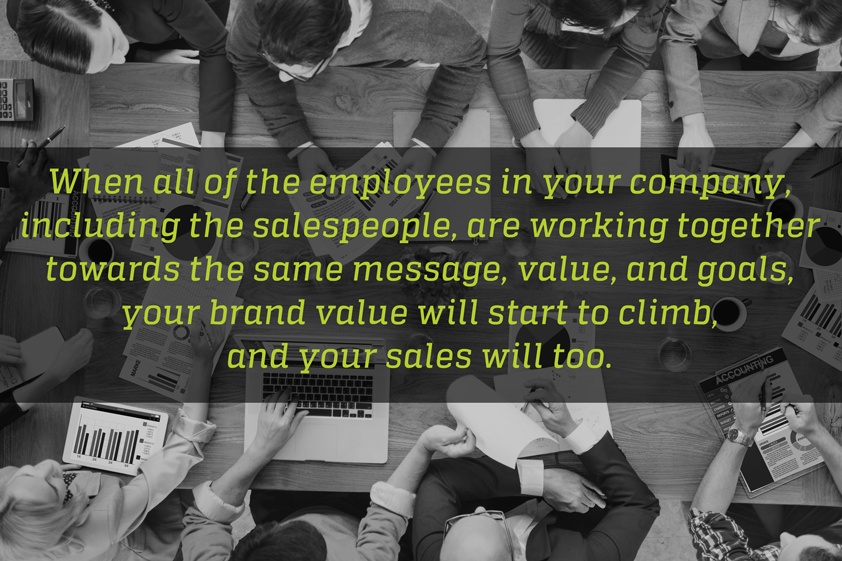
Witness Your Brand Increase Revenue
Align your sales and marketing together in building your brand by answering these questions as a company. Bring in experts to help you if possible (we know of a good one offhand) When all of the employees in your company, including the salespeople, are working together towards the same message, value, and goals, your brand value will start to climb, and your sales will too.The Online Approach to Event Marketing
By
Miri Peled
, 14/05/2017
This post will explain how to effectively integrate the two to achieve your company's greater marketing goals when it comes to marketing a conference
1. The More Targeted the Event, the Better
At an industry conference, you want your booth and company to really stand out among the others. The larger the conference and broader the topic, the more challenging it will be for your product to grab the attention of potential customers. One of our customers, Elcam Medical, for instance, started to see fantastic results after attending more targeted events. After undergoing a branding process which sought to position the company as experts in ensuring safety in the hospital environment, they understood that they were marketing not only to their supplier, but also to their end user -- ICU nurses. You can read more about Elcam's success in integrating online and offline marketing strategies here>> As a result, instead of attending the usual larger medical conferences and trade shows, they began to attend more targeted professional conferences of nurses, albeit with a smaller booth. Since the subject was so targeted, Elcam Medical was often able to generate awareness of their product by speaking on the lecture panel at the conference.2. Be Really Clear About Your Inbound Goals
Make sure everyone in your marketing department is working together towards the same goals. Your inbound marketing activity before, during, and after events can support your greater marketing strategy of lead generation by:- Increasing both direct and indirect traffic to your company website
- Increasing the number of email or blog subscribers
- Educating potential customers about your specific product or service
- Increase the number of requests for a product demo
3. Identify your Call-to-Action (CTA)
A call-to-action, or CTA, is an action which you want potential customers to take. This is the method by which you achieve your goal, which you've properly defined in #2. Your CTA could be to convince potential customers to register for the event, download your ebook or white paper, sign up for your webinar, take a survey, or just visit your latest product or service page. By convincing potential customers to take this action, you are driving them further along the sales cycle. Other parts of your company can benefit from trade shows as well, so it is important to sit down and brainstorm with management in different departments to get their input. One of our clients, Afimilk, decided that in order to promote their new product, the AfiAct II at the World Dairy Expo, they would run a lottery during the event to give away the product to one lucky registrant for free. We integrated a CTA into all of their marketing materials for this event, adding it to the Afimilk website homepage, and creating landing page dedicated to registrations specifically for the event.
4. Create a Dedicated Landing Page to Promote your Event
The best landing pages promote events before and after the event. How? Before the event, they help to schedule appointments with your sales and marketing team, explain exactly what your company will be doing at the event, and promote a particular product or service. After the event, they publish reactions and insights from the event as well as the speaker's presentations on the landing page. Another purpose of your dedicated landing page before the event can be to get specific info from potential customers in order for your sales team to qualify them. But in an environment where you are competing with many other companies for the attention of the same people, you'll need to stand out from the crowd. Why would they want to give you information about themselves? You'll have to offer them something in return. Think really hard about what your potential customer's pain point is and how you can help them – for free, in exchange for their contact information. Here's an example from one of our customers, Plastopil, where we inspired customers to register to an event by offering them a free iPad mini:
5. Promote Your Event via Email Marketing
Invite your contacts to the event with an email beforehand, sending them to your dedicated landing page in order to register for the event or schedule appointments, educating them about your services and products, or offering them a free ebook or white paper to show them you understand (and have a solution to) their main pain point. You may want to send an email promoting the event several times beforehand – perhaps a month, two weeks, and then the week of the event. Follow up afterwards with either a thank you or a newsletter that recalls the event. If you blogged about the event, include those posts in the newsletter as well.
Follow up afterwards with either a thank you or a newsletter that recalls the event. If you blogged about the event, include those posts in the newsletter as well.
6. Combining Online and Offline for Maximum Results
A major goal in B2B conferences is to build new business relationships and strengthen old ones, both of which are key in lead generation. This offline approach should not be underestimated. However, you can use inbound marketing to gain the attention of new potential business partners, educate them about your products and services, and have that first meeting be as effective as possible.Creating an Exceptional Digital Experience for Millennial Buyers
By
Miri Peled
, 14/05/2017
Exceptional Digital Experience. millennial buyers have the first digital contact and are determining which vendors should even be considered by the C-suite.
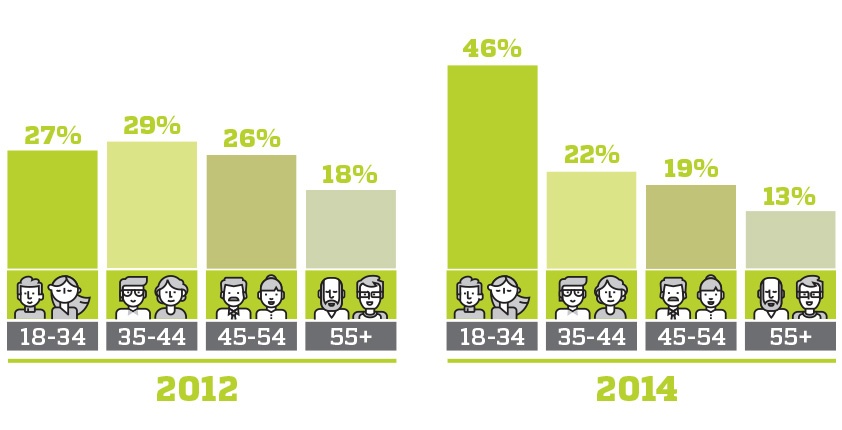 Image by Google/Millward Brown Digital, B2B Path to Purchase Study, 2014
According to an IBM study, millennials value a hands-on, authentic experience with a brand. The challenge for B2B organizations, therefore, is creating a relevant, seamless digital experience that millennials can connect to – at the right time and in the right digital channel.
That's why an exceptional digital experience for all of your customers, including millennials, is so crucial. Since a CEB study found that buyers are now as much as 57% of the way through the buying process before actually engaging with a seller, you need to create a lasting impression that will raise your vendor to the top of the list.
Image by Google/Millward Brown Digital, B2B Path to Purchase Study, 2014
According to an IBM study, millennials value a hands-on, authentic experience with a brand. The challenge for B2B organizations, therefore, is creating a relevant, seamless digital experience that millennials can connect to – at the right time and in the right digital channel.
That's why an exceptional digital experience for all of your customers, including millennials, is so crucial. Since a CEB study found that buyers are now as much as 57% of the way through the buying process before actually engaging with a seller, you need to create a lasting impression that will raise your vendor to the top of the list.
How can your B2B organization transform itself into a digitally mature organization and leave a lasting impression on millennial buyers?
This post will offer three suggestions for creating an exceptional digital experience.Focus on the Customer Experience
Remember what we mentioned above about creating a relevant and seamless digital experience? You'll need to examine your customer's priorities to provide content that focuses on them and their needs. For B2B organizations, this means not only prioritizing strategic concerns such as customer experience, but also growing revenues and reducing costs. It also means making tactical decisions to improve the digital experience (see the graph below).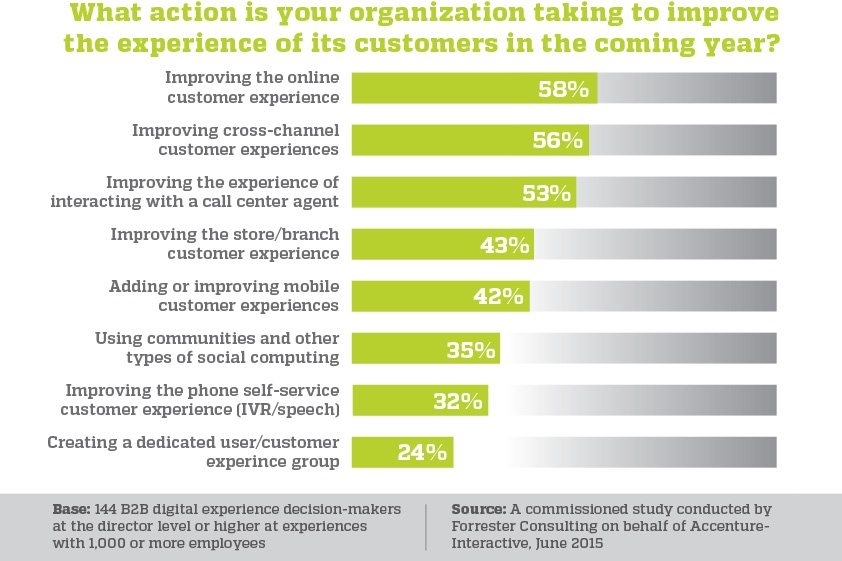 Digital and customer experience for B2B companies are becoming synonymous, and that's why an engaging and relevant digital strategy focuses on the customer.
Digital and customer experience for B2B companies are becoming synonymous, and that's why an engaging and relevant digital strategy focuses on the customer.
Assign the C-Suite Responsibility for Digital Strategy
In order to execute the digital strategy effectively, you'll need guidance from someone who's been assigned responsibility for the digital strategy.In some companies it's the CEO, in others it's a Chief Information Officer (CIO) or chief digital officer. Whatever the title, someone in the C-Suite must lead the company with their end vision, with any changes being a result of this end vision.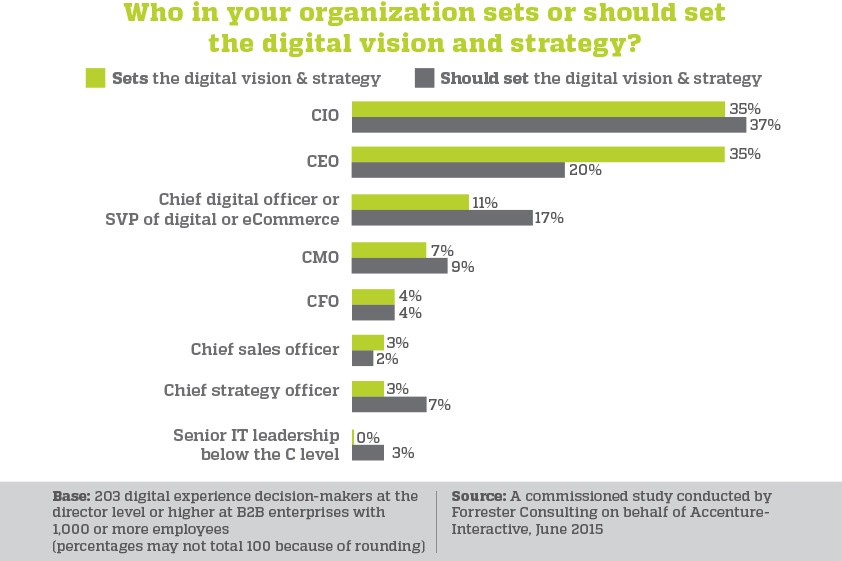 In order to capture and sustain the attention of millennial buyers, you'll need to involve the C-suite to align all parts of your business to provide value to the customer – whether R&D, HR and company culture, or sales.
An exceptional customer experience will reflect this alignment.
In order to capture and sustain the attention of millennial buyers, you'll need to involve the C-suite to align all parts of your business to provide value to the customer – whether R&D, HR and company culture, or sales.
An exceptional customer experience will reflect this alignment.
Employ the Right Third-Party Solution Providers
Whether it’s front-end applications, performance analytics, web design or content strategy, your company may realize it needs support from a third party to reduce risk and help them gain expertise. According to this Forrester study on digital transformation in B2B, 87% of companies use a third-party solution for at least one component of their digital transformation. One of the conclusions of the Forrester study is that it is vital to choose a third-party vendor that not only provides time and materials, but an end-to-end partnership as well. Find a solution that understands your broader goals in the marketplace and have them accountable for some measure of quantifiable success (whether it be more traffic, a lower bounce rate, or higher keyword rankings).Getting on the Short List
By focusing on the customer experience, assigning someone in the C-Suite responsibility over digital strategy and choosing the right third-party vendor, you'll create a digital experience that is successful in catching and sustaining the attention of B2B millennial buyers. In addition, you'll have to provide them with relevant and engaging top-of-the-funnel content in the channel of their preference. For now, these millennial "buyers" may just be influencers determining which companies are on the short list. All the more so that their digital experience be exceptional.Your Employees as Your Main Brand Ambassadors
By
Dina Gidron
, 14/05/2017
Yes - your employees. They are one of the most important success factors of your brand implementation. They are your most significant brand ambassadors.
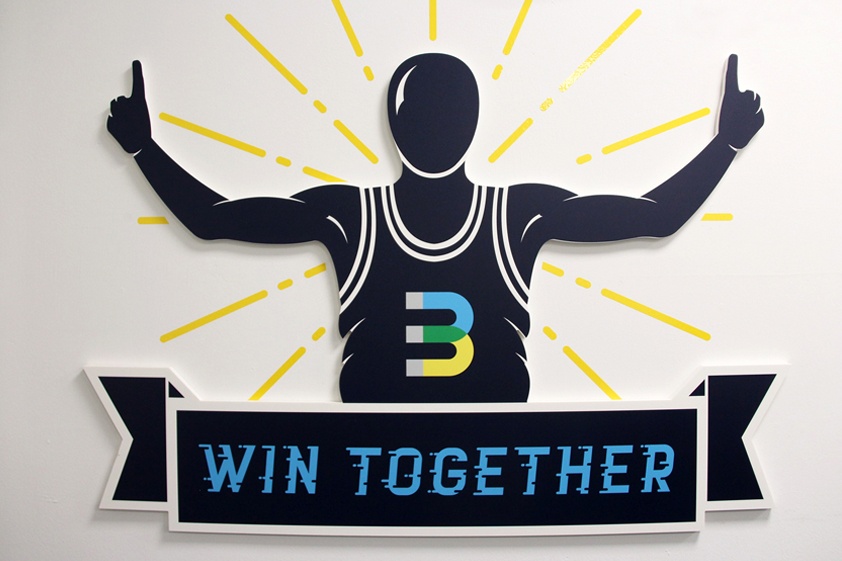 To achieve this, you need to focus efforts on:
To achieve this, you need to focus efforts on:
- Only recruiting employees who believe in what you believe in.
- Engaging your employees by creating a challenging and fulfilling work environment that encourages innovation and maintains a healthy work-life balance.
From Israel to Global: Lessons Learned in Building a Global Brand
By
Orit Oz
, 14/05/2017
Mr. Eyal Tryber,CEO of Maytronics and former CMO, talks about the lessons learned from his own first-hand experience, from building a global brand
 Let's start off with a bit of background about the company. A company with humble beginnings – it was founded on Kibbutz Yizreel in Northern Israel in 1983 – Maytronics has come a long way in the automated pool cleaning market. With over a billion shekels in market value, over 400 employees and operations in 46 countries and more than one million pool-cleaning robots sold, Maytronics is now a prosperous global company. The company is publicly traded both on the NASDAQ and the Tel Aviv Stock Exchange.
After going public in 2004, the company embarked on a new marketing strategy: creating anchors in strategic markets. Company branches were established in Argentina, the US, France, Australia and Spain. Their strategy paid off as the company began to achieve unprecedented growth. As it grew, however, new challenges arose. First, each company branch started to create its own multi-culture, which created tension between local and global brands. Secondly, as the company grew, it risked losing its unique Maytronics company culture – stemming from its humble Israeli kibbutz origin and culture.
Let's start off with a bit of background about the company. A company with humble beginnings – it was founded on Kibbutz Yizreel in Northern Israel in 1983 – Maytronics has come a long way in the automated pool cleaning market. With over a billion shekels in market value, over 400 employees and operations in 46 countries and more than one million pool-cleaning robots sold, Maytronics is now a prosperous global company. The company is publicly traded both on the NASDAQ and the Tel Aviv Stock Exchange.
After going public in 2004, the company embarked on a new marketing strategy: creating anchors in strategic markets. Company branches were established in Argentina, the US, France, Australia and Spain. Their strategy paid off as the company began to achieve unprecedented growth. As it grew, however, new challenges arose. First, each company branch started to create its own multi-culture, which created tension between local and global brands. Secondly, as the company grew, it risked losing its unique Maytronics company culture – stemming from its humble Israeli kibbutz origin and culture.
Bridging Gaps in Cultural Differences While Sustaining Continuous Growth
And thus, Maytronics embarked on an international organization process with Oz. Oz carried out this process in two ways. First, it enhanced the company dialog in order to form one distinct Maytronics company culture. This in turn helped build a strong global brand with a highly committed team located all over the world. Or as Tony Hsieh, CEO of Zappos put it: "We believe that your company's culture and your company's brand are really just two sides of the same coin." In order to form this distinct company brand and culture, Oz and Maytronics brainstormed together a list of its core values, applying the "Golden Circle" concept of Simon Sinek. According to this concept, products (the what) and the development (the how) serve to achieve a company purpose (the why). This also assists in creating an understanding of the company's competitive edge in the marketplace.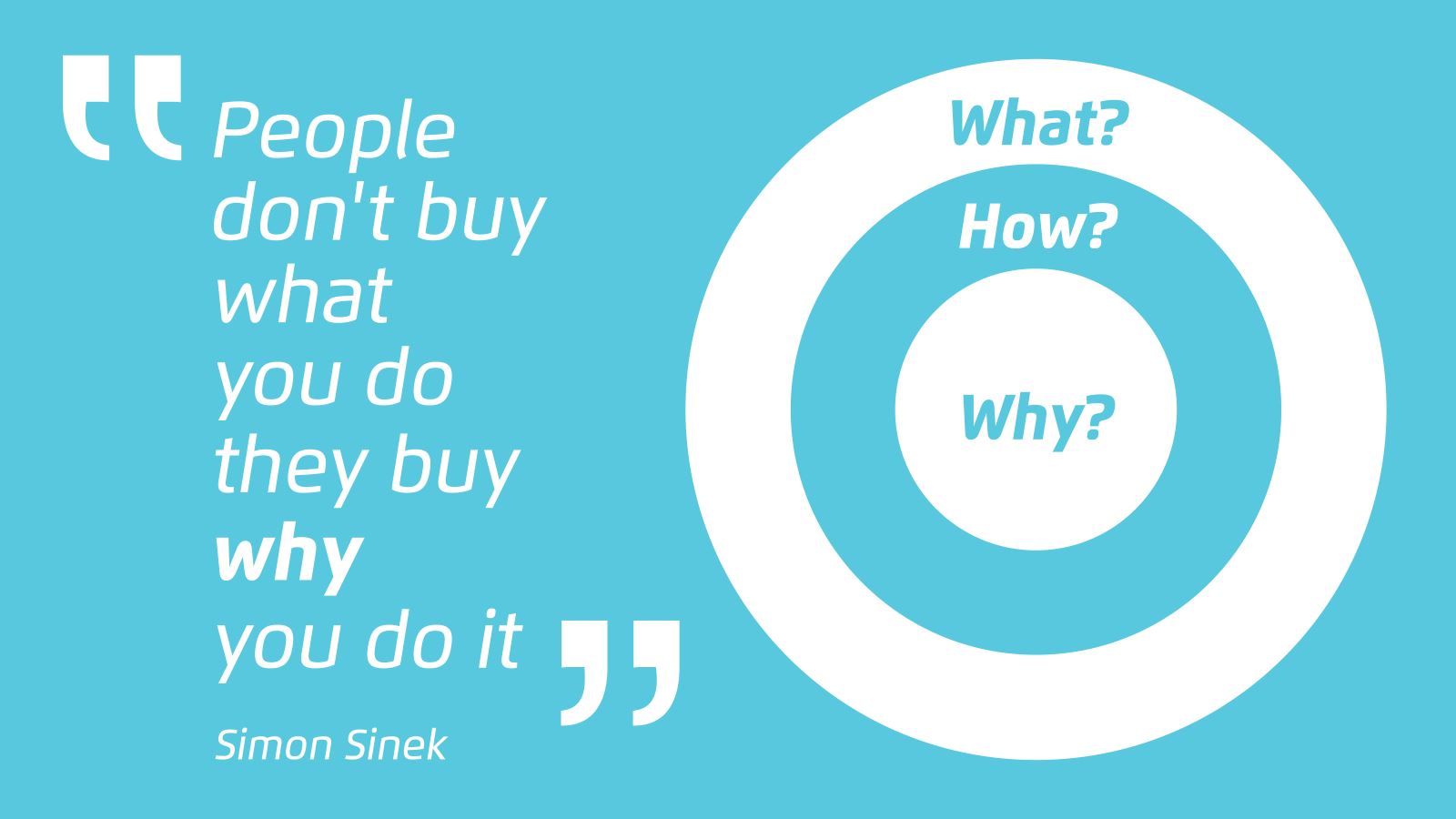 What are Maytronics' core values? Most importantly, the company believes in focusing on the customer. Along with this are professional values of integrity and fairness. Together these are the internal values, or company culture, of Maytronics.
What are Maytronics' core values? Most importantly, the company believes in focusing on the customer. Along with this are professional values of integrity and fairness. Together these are the internal values, or company culture, of Maytronics.
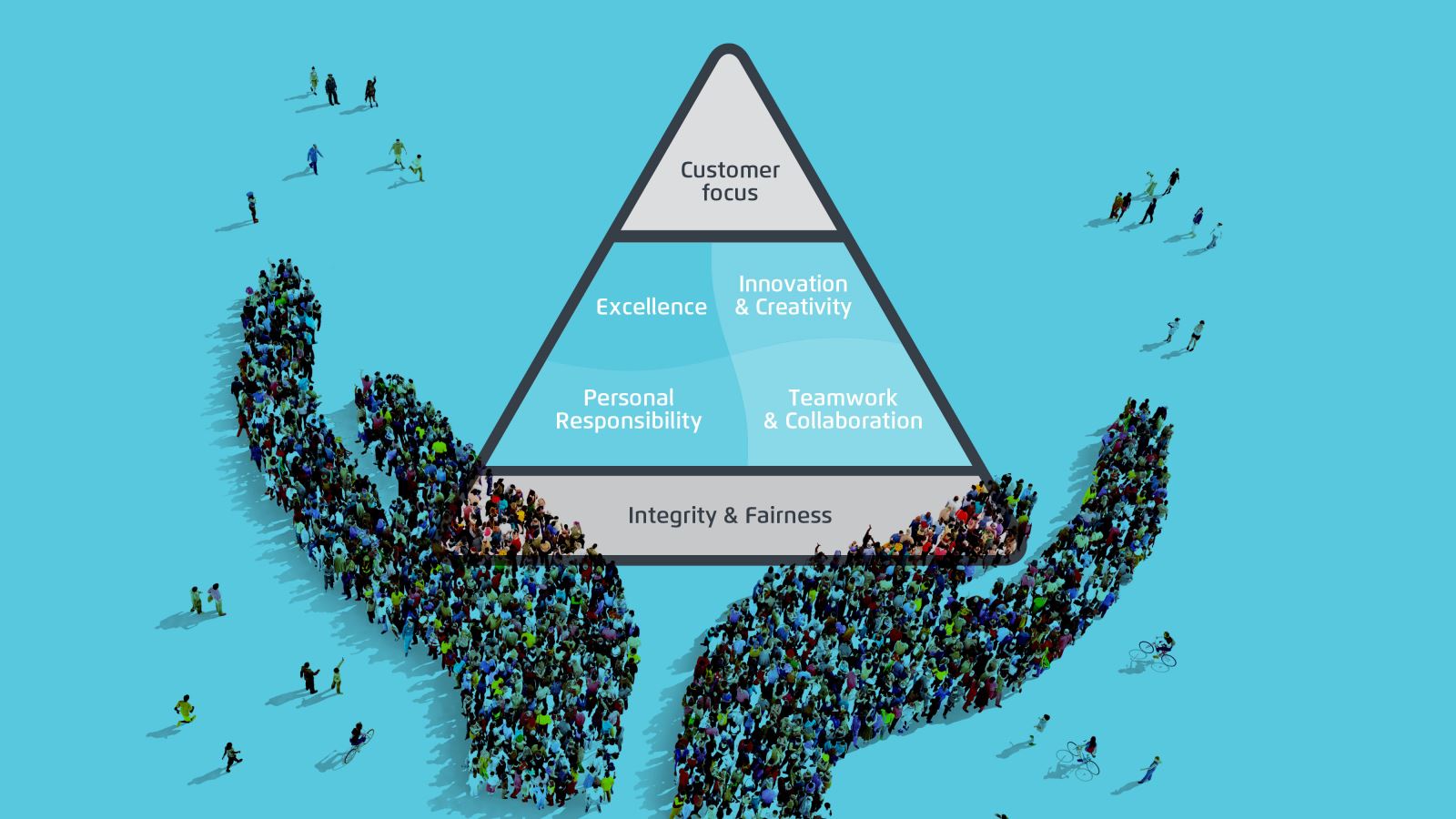 Other values, while important, are components assisting in delivering these primary values. Although Maytronics develops pool cleaning robots, this alone doesn't fully encapsulate the company's purpose. As Mr. Tryber stated in his talk at the conference: "We don't sell robots, we sell an exceptional customer experience."
Other values, while important, are components assisting in delivering these primary values. Although Maytronics develops pool cleaning robots, this alone doesn't fully encapsulate the company's purpose. As Mr. Tryber stated in his talk at the conference: "We don't sell robots, we sell an exceptional customer experience."
 Oz successfully transformed the company's internal values, or company culture, flipping them to discover the other side of the coin: the company's brand.
Oz successfully transformed the company's internal values, or company culture, flipping them to discover the other side of the coin: the company's brand.






















